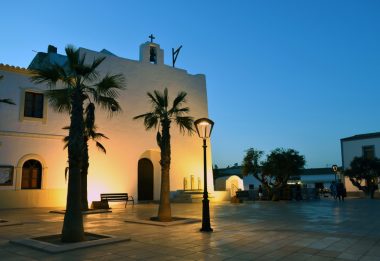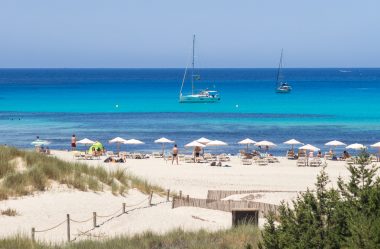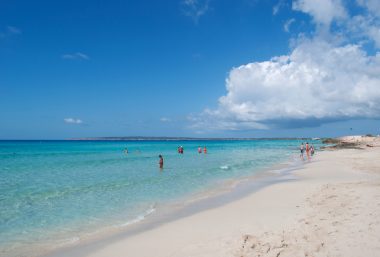Due to tourism, the population of Formentera has more than tripled since the seventies and especially since the turn of the millennium. This was initially due to the arrival of workers and, since the nineties, increasingly to people who have decided to live permanently on the island.
As long as the interior of the island is not used for agriculture, such as viticulture, pine forests and juniper grow there. Catalan has been spoken in Formentera since the 13th century.
The climate of Formentera
The climate in Formentera is temperate subtropical. With an average annual temperature of over 16 degrees, Formentera is the warmest island of the Balearic Islands, but also the driest due to the low rainfall.
The mass tourism of the nineties, like all the islands of the Balearic Islands, has of course also shaped Formentera, but not to the same extent as the other islands. Formentera has largely been spared the ruthless construction boom that has given other islands soulless concrete castles, the beaches are still almost completely unspoiled, and the hotels are essentially concentrated in a single place. Formentera has been able to retain much of its original tranquillity. This is certainly also due to the fact that the island can only be reached by ship. Nevertheless, about 450,000 passengers arrive at the ferry port of La Savina every year.
The towns in Formentera are San Francesc de Formentera, Sant Ferran de ses Roques, Es Cap de Barbaria, Es Pujols, El Pilar de la Mola, La Savina and Es Caló.
San Francesc de Formentera

San Francesc de Formentera is the main town of the island. Sometimes, however, the place is also called San Frances Xavier; the Spanish name is San Francisco. “Hauptort” because the town hall, the main post office and the police station are located here. Actually, Formentera is not further divided politically. San Francesc has about 1,400 inhabitants in the town and about 1,700 in the surrounding area.
In San Francesc there are good restaurants and also good shops. In addition, the daily art market takes place here in the season, where not only arts and crafts and jewellery are offered, but also, for example, clothing and – for “self-propellants” – wool.
Sights in the village are the fortified church of San Francesc Xavier from the 18th century and the chapel of Sa Tanca Vella from the 14th, possibly even from the 13th century. There is also an interesting ethnological museum in the village, the “Museu Etnològic”.
In San Francesc de Formentera, the feast of the patron saint of the island, St. James (Festa de San Jaume), is celebrated on 25 July and the feast of the patron saint of the town (Festa de Sant Francesc) on 3 December. About three kilometres from the centre of the village is the port of La Savina.
Sant Ferran de ses Roques
The town of Sant Ferran, in Spanish San Fernando, is located directly east of San Francesc. The village itself has about 1,000 inhabitants, another 2,000 live in the area. San Ferran was the center of hippie culture on Formentera in the sixties. Speaking of “hippie culture: the Canadian songwriter Joni Mitchell wrote part of her famous album “Blue” in Formentera in 1970.
On 30 May, Sant Ferran celebrates the Festa de Sant Ferran, the feast day of the patron saint of the town.
El Cap del Barbaria

The “Barbarian Cape” is particularly known for its outstanding sight in the truest sense of the word, the lighthouse on a cape over 100 meters high. The American songwriter and current Nobel Prize winner for literature Bob Dylan lived in the lighthouse for a while in the seventies.
Es Pujols
The town of Es Pujols is the place where tourism is concentrated in Formentera. Es Pujols has less than 900 inhabitants, but it is home to almost all the hotels on the island and all the facilities relevant to tourism, such as restaurants, bars and discos. Formentera’s tourist nightlife is almost exclusively found in Es Pujols. The town is located on an almost two-kilometre-long bay with the beach Playa d’Es Pujols. In the high season, there are regular buses from Es Pujols to the other towns on the island.
El Pilar de la Mola
El Pilar is a small town with only about 200 inhabitants. Another 600 people live in the vicinity of the village.
Worth seeing in the village are a pretty 18th century church reminiscent of Cubism despite its age, an old windmill and especially another lighthouse of the island, the Far de la Mola. It was built in 1860. Here is a memorial stone in honour of the French writer Jules Vernes, in whose novel “Journey through the World of the Sun” the lighthouse plays a role. The lighthouse stands on a cape almost 150 meters high.
In El Pilar de La Mola there is also a craft market twice a week during the tourist season.
A small town that belongs to El Pilar de la Mola is Es Caló, which was once the only port in Formentera before the port in La Savina was opened. Es Caló has a fine sandy beach about 100 meters long and 25 meters wide. The harbour itself is still in operation for pleasure and fishing boats.
Holidays in the village are 24 June, St. John’s Day, and 12 October, the feast day of the patron saint Pilar.
La Savina
La Savina, Spanish name La Sabina, has about 800 inhabitants and is home to the port of the island of Formentera. This is where ferries coming from Ibiza and the Spanish mainland dock and depart. With the Far de La Savina, this place also has a lighthouse worth seeing.
Other sights
Near the town of Es Pujols, on the Punta Prima headland, there is a defensive tower dating back to the Middle Ages. Also near Es Pujols is the salt lake Estany Pudent with its salt pans used for salt production.
Beaches in Formentera

“Migjorn” is the name of the south coast of Formentera. Here there are more than five kilometers of beach after beach, only interrupted by rocky areas. Each beach has its own name: Mal Pas, Es Ca Marí, Es Racó Fondo, Es Codol Foradat, Es Valencians beach, Es Arenals and Es Copinar. The most popular beaches are Ca Mair, Es Arenals and Es Copinar. Since the winter ocean currents reshape the landscape here every year, the beaches can look different from year to year. There are numerous restaurants and hotels in this area of the island, although most of the tourist facilities are located in the town of Es Pujols.
The town of Es Caló has a fine-grained sandy beach about 100 meters long and 25 meters wide. Hotels and restaurants can also be found here. On a long headland northwest of Es Pujols there are beaches, the most famous is Platja de Ses Illetes and right next to the beach Llevant, less known, but at least as beautiful and much quieter.
Cavall d’en Borràs beach is only about two kilometres from the port of La Savina and is therefore also well suited for a day trip from Ibiza with its crystal clear waters. Cala Saona beach can be reached from Cap de Barbaria and is located between two cliffs.
The beach of the main tourist town of Es Pujols stretches over a length of 600 meters. Another nearby and somewhat quieter beach is Sa Roqueta. Restaurants and hotels can be found on all the beaches, although, again, Es Pujols is the tourist heart of the island of Formentera. By the way, nude bathing is allowed practically everywhere on the island.




